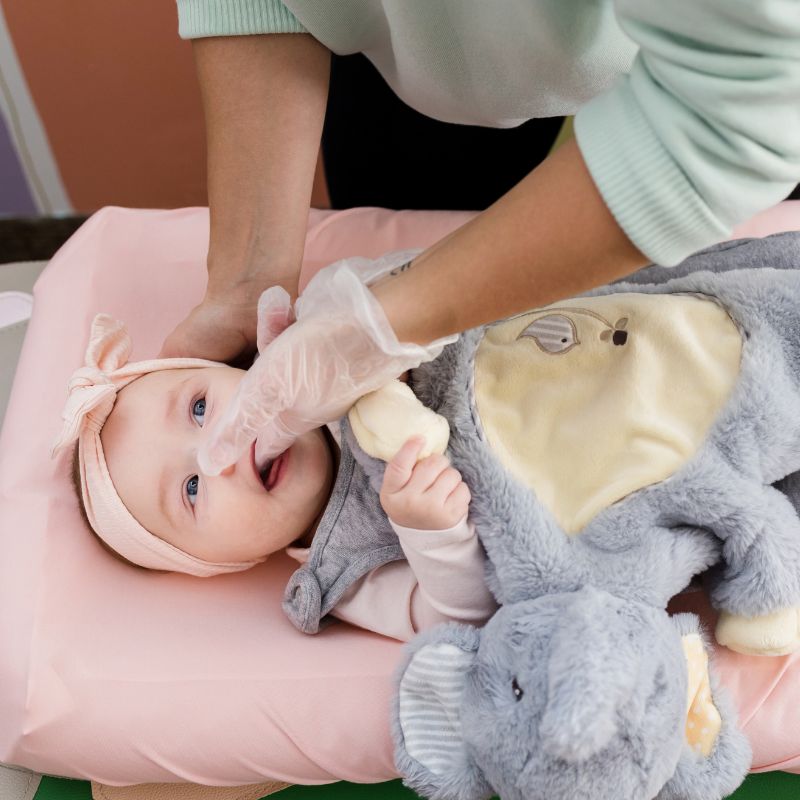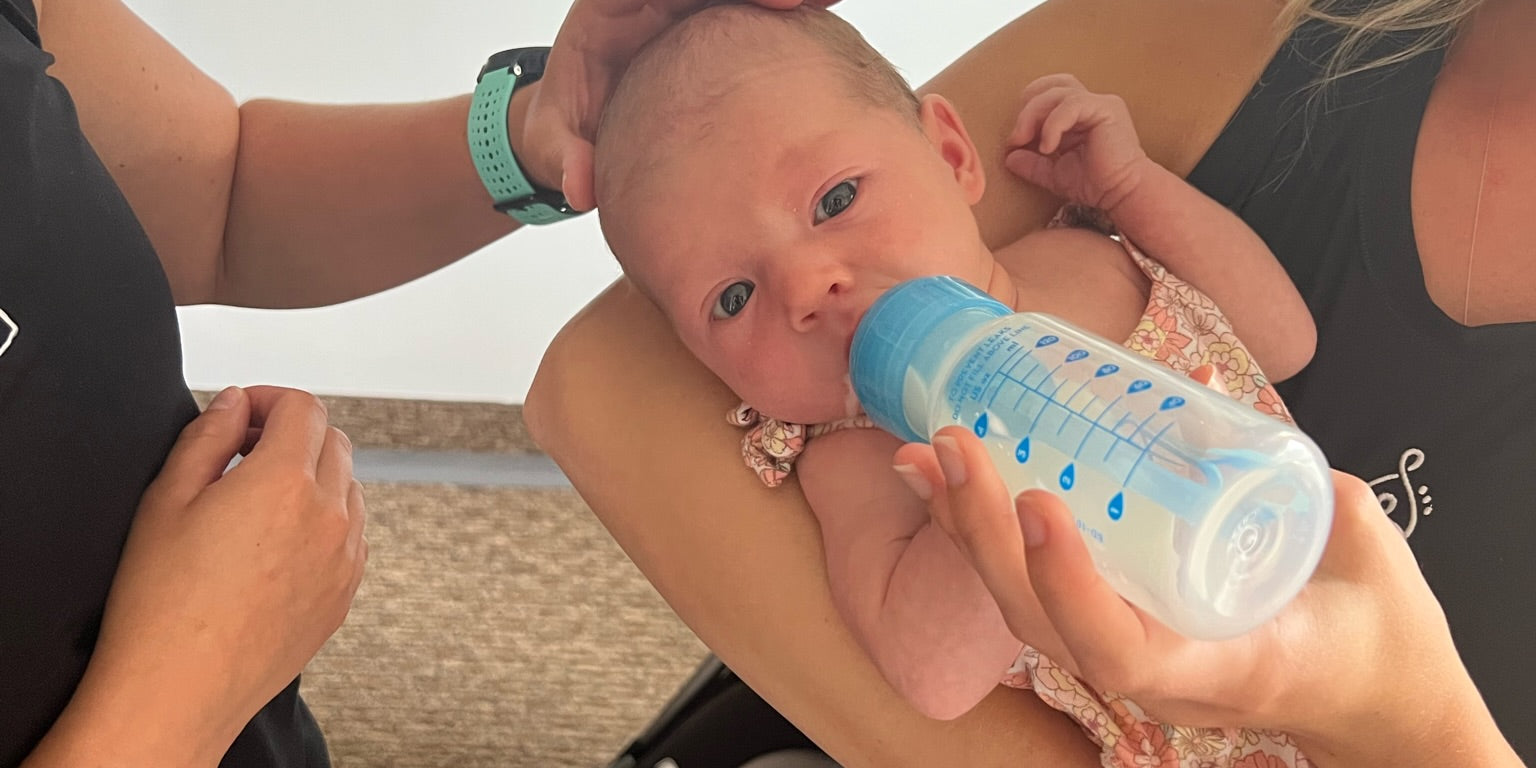What are Tongue Ties?
While babies are growing + developing inside mama's belly, there is a strong band of tissue located in the center of the mouth that guides the development of the mouth-- like the jaw, supporting muscles, and palate. This band of tissue is called a frenum [frenulum]. By the time we are born, this frenum [frenulum] is supposed to recede and become thin. However, in about 4-10% of children, this doesn’t occur, which leaves the tongue connected to the floor of the mouth. When a frenum [ frenulum ] is too short, thick, or inhibits movement & function, it is referred to as a "tongue tie".
What Does a Lip Tie Look Like?

A lip tie is similar to a tongue tie. Rather than being under the tongue, the restricted oral tissue is under the upper lip. Lip ties can actually be easier to spot in some cases! A tight upper lip frenulum can connect lower on the upper gums or ever wrap under the gum line to the roof of the mouth [hard palate]. Lip ties often coexist with other oral restrictions, like tongue and buccal ties. As the teeth come in, you may notice a gap in the front teeth as a result of the lip tie connecting behind the gums. Lip ties by themselves typically causes less functional issues compared to tongue ties, since they are not inhibiting tongue mobility and function. However, lip ties often coexist with other oral restrictions, like tongue and buccal ties.
Signs of Tongue or Lip Ties in Babies
- Difficulty breastfeeding
- Clicking or noisy suckling
- Popping on + off the breast
- Poor weight gain
- Coughing or gagging
- Lip blisters
- Noisy breathing/snoring while sleeping
- Reflux + frequent spit ups
- Milk dribbles out of mouth during feeding
- Milk coming out of the nose
- Colic symptoms [cries often]
Signs of a Tie in Moms
- Flattened or cracked nipples after breastfeeding
- Nipple pain// Bleeding nipples
- Nipple thrush
- Prolonged feedings
- Poor breast drainage
- Decreased milk production
Many of the symptoms that mom may experience are related to breastfeeding + milk production. Some mothers get anxiety and feel a sense of guilt with breastfeeding difficulty, when it typically has nothing to do with the mother. An infant with a tongue tie isn’t able to latch deeply — around the entire nipple and areola. This compresses the nipple leading to nipple pain + skin irritation. Some infants will stay attached to the nipple for a long period of time but not take in milk and others may only feed during mom’s let down period because milk is flowing more easily. The lack of stimulation then decreases the amount of milk mom produces.
Why Should You Care About Oral Ties?
The connection between the oral tethers and the rest of the body are almost unbelievable. The small membrane on the bottom of your tongue is fascia and actually connects all the way to your big toe. Fascia is essentially a tough plastic wrap that surrounds all our muscles and organs. Because of this extensive fascial connection, babies with oral restrictions often present as fussy, tense/tight, or colicky. They also can present with increased reflux, gas, & constipation, as well as appear seemingly "uncomfortable" overall.
Tongue Ties & Reflux
When a babies latch is not optimal, meaning there is an inadequate seal, they can swallow air when feeding. This excessive air swallowing is known as 'aerophagia', which can cause reflux symptoms in infants. It also contributes to increased gas because of the air bubbles in the belly! Short maxillary labial frenula (lip tie) and ankyloglossia (tongue tie) can contribute to aerophagia in infants. This is known officially as aerophagia induced reflux (AIR).
It is not uncommon that babes with oral ties exhibit diaphragm tightness, that contribute to their reflux symptoms. This is partially due to the relation of the diaphragm, esophagus, and stomach. The other component to this goes back to the fascial connections we talked about earlier. The tongue fascia connects into the deep front line, which includes the diaphragm! So tension in the mouth [tongue tie] can lead to tension in the diaphragm causing reflux.
Chiropractic care is one option for babes battling reflux, regardless of the culprit!
Tongue Ties & Colicky Babies
'Colic' is a term used to describe a baby that has recurrent, prolonged periods of crying or fussiness, and sleeping problems. This can be a sign that your babe has oral ties or body tension. Similar to reflux, colic can be the result of poor feeding. Remember, babes are new to feeding, but have the intuitive instincts that are essential for feeding ease and success. A baby with a tongue or lie tip has more work and adaptation to overcome to feed properly and adequately. Luckily, chiropractic care and craniosacral therapy can be effective treatments for both colic and oral ties.
Treatment for Tongue & Lip Ties
- Consult your pediatric chiropractor
- See a craniosacral therapist for body work
- Schedule an appointment with a qualified lactation consultant to work on improving babes latch
- Consult a pediatric dentist to assess the severity of oral restrictions and determine if a revision is necessary
Oral Restrictions & Chiropractic
Chiropractic care and craniosacral therapy (CST) cannot make tongue and lip ties disappear. Rather these treatments help support the body and reduce tension and stress in your baby. By reducing tension in the tissue connecting the mouth to the toes we promote optimal oral functioning [so babe can eat like they should!]
The Role of Craniosacral Therapy
Craniosacral therapy [CST] can also be a helpful addition to the revision process, since it addresses full body function & tension, not just oral function. Getting the tethered oral tissue evaluated & revised by a pediatric dentist along with specialized chiropractic care could be life changing for mamas & babies dealing with oral ties. [We work with amazing pediatric dentists in the community!]. Typically, we like to see infants 1-2 times before their revision and 2-3 times post-revision. This allows the body to get ready for the release as well as aid in the healing process!
::::::::::::::::::::::::::::::::::::::::::::::::::::::::::::::::::::::::::::::::::::::::::::::::::::::::
Baxter, R., Musso, M., Hughes, L., Lahey, L., Fabbie, P., Lovvorn, M., . . . Agarwal, R. (2018). Tongue-tied: How a tiny string under the tongue impacts nursing, feeding, speech, and more. Pelham, AL: Alabama Tongue-Tie Center.
Siegel, S. (2016). Aerophagia Induced Reflux in Breastfeeding Infants With Ankyloglossia and Shortened Maxillary Labial Frenula (Tongue and Lip Tie). Int J Clin Pediatr. 2016;5(1):6-8



